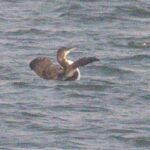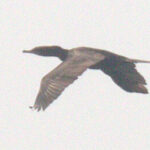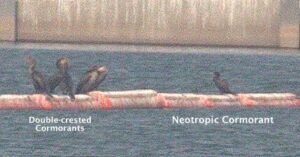Few things excite birders more than seeing a new bird for their “Life List.” It’s even more exciting when the new bird is also a “first” for a given region, often the birder’s home county. When the bird is exceptionally rare and out of range, the excitement builds even more, so when Ralph Baker found a bird that normally occurs in the tropics and southern United States from Texas east, the thrill multiplied exponentially. Here’s his account of the sighting.
There is a phenomenon famous among birders called, “The Patagonia Picnic Table Effect.” It’s also known as, “The Patagonia Roadside Rest Stop Effect.” It occurs when a rare bird is found and reported at a given location and other birders go there and find even more rare birds.
It started as a phenomenon with a name at the Patagonia Roadside Rest Stop, near the town of Patagonia, Arizona, when someone found a bird that had never been reported north of the Mexican border. When others went to look for this bird, they found more birds that had never been reported north of the border and Patagonia became famous.
I’ve seen the phenomenon play out a few times since I became a birder; it’s happened to me twice at the 28 Mile Road Bridge at Woodward Reservoir, in Stanislaus County. Sunday, August 30, was the second time.

Richard Brown had seen a Common Loon there a couple days earlier. When our mutual friend Jim Gain went to see it, he also saw a Pacific Loon. He found it Saturday and reported it on the local list serve and ebird. It was only the second Stanislaus County record of this species.
On Saturday, I had been out birding in Modesto all morning and into the afternoon, but when I got home and saw the report from Jim, I quickly changed back into my birding clothes — which means I put my pants back on — and headed for the door. I had missed the first record of this bird and didn’t want to miss it again.
I arrived at the bridge about 10 minutes before 5:00 and stared into the sun glaring off the water for the next hour. No loon. So I went home with plans to get up early Sunday morning and try again. I wanted this bird for my Stanislaus County list!
Sunday, I woke up a little before 6:00, showered and headed out. I arrived at the bridge just before 7:00. There was a crowd of about 100 high school kids blocking my way; they were there for their “Senior Sunrise Day.” I try to avoid crowds anytime, and especially these days, so I drove slowly through the group, many of whom were reluctant to move out of the way.
I finally got through and headed for the north-shore day use area. From there, it’s possible to scope the entire length of the dam, where most of the loons that have been reported from the reservoir have been seen. I thought I might get lucky. I did not. So I reluctantly left and went back toward the bridge.

When I got there, I ran into John Luther, a dedicated birder who had come all the way from the Bay Area to look for the loon. Also there were my friends Jodi Smith and Richard Brown, who had started things with the Common Loon sighting.
John told us that he had already seen the Pacific Loon and then he left. The kids had all left by this time, as well.
With the bridge all to ourselves, Richard, Jodi and I settled in to watch for the loon. We continually scanned the water west of the bridge and after a while Richard said, “I’ve got it!”
Soon, all three of us were watching the Pacific Loon preening. The bird was about a quarter-mile away, but with our scopes we could see enough detail to make the ID. We snapped quite a few photos, but nothing that would win any prizes, even in a “half-way decent photo” contest.
Jodi decided to head home, but Richard and I stayed for a while, still hoping for at least one good photo. We were both glad we did.
While we were waiting for the loon to come back, I began counting the other birds in view for our ebird list. I was scanning the floating boom half-a-mile west of the bridge and counting the cormorants when I noticed that one looked considerably smaller than all the others. It appeared to have a much smaller bill as well.

I had an idea of what it might be, but Richard’s and my telescopes were not powerful enough to pick out much detail. Just a few minutes later, the bird took off. However, it came right at us! It flew over the south end of the bridge, roughly 150 feet from where we were standing, heading east-by-southeast until it was out of view. Luckily, Richard was clicking away with his camera the whole time.
I was fairly confident in my ID, but after Richard emailed a few of his pictures to me I forwarded them to a few local birders and, at Jim Gain’s suggestion, posted them on a couple of birders’ list serves for opinions.
The first response I got was from birding legend and pelagic trip leader extraordinaire Alvaro Jaramillo, who said, “Hi, looks perfect for a Neotropic to me! Nice. Still looking for one to show up in San Mateo county.” Other responses substantiated my ID.
Richard and I had found a NEOTROPIC CORMORANT — a tropical species very rarely seen in California, and then almost exclusively in the southern part of the state. It was not only a life bird for both of us but a first record for Stanislaus County.
One of the things that has been very high on my bucket list for a LONG time is finding a first county record for Stanislaus, and this time the Patagonia Picnic Table Effect had delivered one. I have been quite happy ever since!

Excellent! Perfect editing, too, you made it much more concise than I did!
What happened to all the valley Meadowlarks?